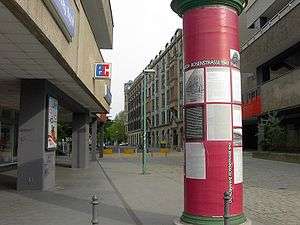Fabrikaktion
The Fabrikaktion (Factory Action) is the term for the roundup of the last Jews to be deported starting 27 February 1943. Most of these remaining Jews were working Berlin plants or they were working for the Jewish welfare organisation. The term was coined by the victims after World War II, the Gestapo called the plan Großaktion Juden (Major Action (on) Jews) and in the communications with the factories it was named Evakuierungsaktion (Evacuation Action). While the plan was not restricted to Berlin it became later most notable for the ensuing Rosenstrasse protest in Berlin.

Situation
In September 1942 there were about 75,800 Jews left for labour in the arms industry. Hitler asked on 22 September 1942 to replace them with other people sent in for forced labour. The RSHA took action planning multiple deportation trains to Riga and Auschwitz. Because the war consumed most of the transportation capacity the deportations were not performed immediately but the factories were informed that their Jewish labour workers would be "evacuated" at the end of March 1943.
In the beginning of 1943 the plan included 15,100 Jewish workers in Berlin and 5,300 outside of the capital with most of them living in major cities or labour camps. On 20 February 1943, SS-Obersturmbannführer Adolf Eichmann (a main architect of the Holocaust) and head of sub-department (Referat IV B4) of the RSHA issued details on the "technische Durchführung der Evakuierung von Juden nach dem Osten" (Technical Procedures for the Evacuation of Jews to the East). Within that plan some groups of Jews would be excluded from deportation which were:
- Jewish partners in mixed marriages
- Married Geltungsjuden (people considered to be Jewish under the Nuremberg laws) living with Aryan relatives
- Jews over age of 65 unless married to Jews below that age
- Jewish veterans of the First World War carrying medals
- and a list of special persons listed by name
Though these persons would not be deported they would not be allowed to work in the arms industry. They were to be placed into different positions where they could be called in without the factories to intervene on the deportation.
Action
In most of the cities the Jews were called in on 26 February 1943 to register the next day with the Gestapo for a check of their labour papers. In Breslau most of the Jews were rounded up without prior signals on the morning of 27 February by interception at their home or work place and transported to the synagogue. In Dresden the labour camp Hellersberg was used for concentration. In most parts of the Reich these actions were finished after two days.
The situation was slightly different in Berlin due to the larger number of Jews so that it lasted about a week. Unlike other locations there were no signals before the "evacuation" took place - Gestapo and SS entered and rounded up the Jews from 100 factories in a coordinated action. The arrested persons were transported to six locations in Berlin for concentration:
- the main hall of the Clou Concert Hall (a former covered market) on Mauerstraße in Mitte district
- a garage in the Hermann Göring Barracks in Reinickendorf district
- the horse stalls of a barracks on Rathenower Straße in Moabit district
- the synagogue on Levetzowstraße in Moabit
- the Jewish Senior Center ("das jüdische Altersheim") on the Großen Hamburger Straße in Mitte district
- the house of the Jewish Community on Rosenstraße in Mitte
The "Fabrikaktion" is perhaps especially noted for engendering the Rosenstrasse protest, in which the "Aryan" wives of Jewish prisoners protested in front of the Jewish Community on Rosenstrasse for the release of their Jewish husbands.
Fugitives
About 4000 of the persons were able to escape. This matches with stories of survivors telling that they had been warned by their colleagues and foremen - in one case even a police officer - shortly before the action took place. On the other hand, most of the fugitives were captured - the Gestapo used search service and the help of Jewish "Greifer" collaborators. It is estimated that only 1,500 Jews were able to hide away until the end of the war.
Literature
- Wolf Gruner: Widerstand in der Rosenstraße. Die Fabrik-Aktion und die Verfolgung der „Mischehen“ 1943. fibu 16883, Frankfurt 2005, ISBN 3-596-16883-X
- Claudia Schoppmann: Die "Fabrikaktion" in Berlin. Hilfe für untergetauchte Juden als Form des humanitären Widerstandes. In: Zeitschrift für Zeitgeschichte 53 (2004), H.2, Seite 138-148
- Beate Kosmala: Missglückte Hilfe und ihre Folgen: Die Ahndung der "Judenbegünstigung" durch NS-Verfolgungsbehörden. In: B.Kosmala / C.Schoppmann (Hrsg.): Solidarität und Hilfe für Juden während der NS-Zeit. Band 5: Überleben im Untergrund. Berlin 2002, ISBN 3-932482-86-7